Understanding Siteimprove Reports
Overview
Our Siteimprove reports help site editors identify and fix issues that affect website quality, SEO, and accessibility. This guide breaks down each section of the report to help you understand what the scores mean, why they matter, and what you can do to improve them.
Login
The Siteimprove reports you receive via email are most useful when viewed on the Web. Click the link provide in the email you've received to view your report on the Siteimprove site. Login should be automatic. However, if it's not, and you are asked to sign in, please make sure you use the "Sign in with SSO" option on the sign in page. "SSO" is a method of authentication we use to allow you to sign into sites using your Saint Joseph's login without having to
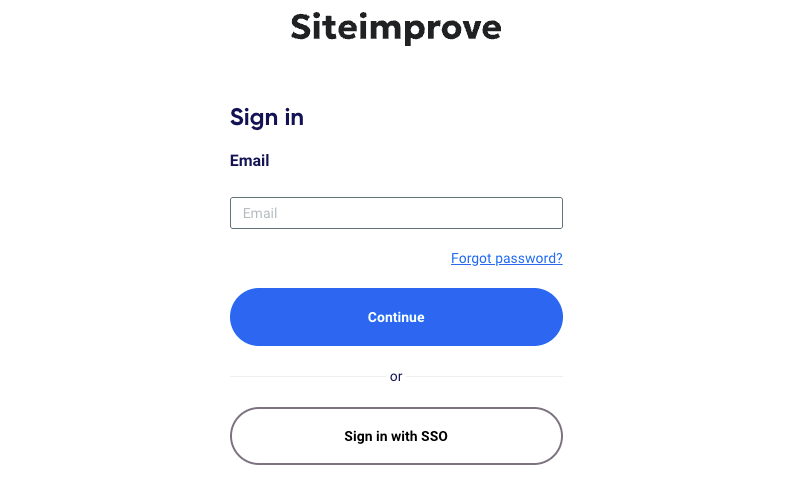
To do this:
- Click the white "Sign in with SSO" button before doing anything else.
- Enter your Saint Joseph's email address on the screen that appears after you've clicked the button.
- This will prompt you to log into your Saint Joseph's account, which will give you access to your report.
Index Scores
Although the top score in Siteimprove is 100, you are not expected to get a perfect score. A score of 90+ means you are in the top 5% of websites monitored by Google. Anything below 90 on your DCI, Quality Assurance, and SEO indices bears further investigation and remediation.

Digital Certainty Index
What do the DCI number and the other index numbers mean?
The Digital Certainty Index (DCI) is a measure of the quality and potential impact of a site's digital presence, including:
- A website’s accessibility and usability
- A website’s credibility and trustworthiness
- How well-positioned a website is to respond to SEO challenges
How is it calculated?
The DCI Score is calculated based on a website's performance across three categories: Quality Assurance, SEO, and Accessibility. Each module makes up one third (33.33%) of the Overall DCI Score.
Quality Assurance Score
This score reflects a website’s credibility and trustworthiness regarding its user-facing characteristics. Your website's Quality Assurance Score is determined by its performance in four subcategories: Content Quality, Content Freshness, User Experience, and Security.
What is It? | What's needed for a high score? | Weighting Priority | |
| Content Quality | The editorial quality of a site's content, which affects how quickly and accurately users are able to comprehend it. |
| Medium |
| Content Freshness | How up-to-date a site's content is, which affects user retention and engagement. It also impacts a site's SEO rankings. |
| Low |
| User Experience | How conducive a site's content is to smooth navigation around the site. |
| High |
| Security | How vigilant a site has been in only linking to safe domains, and in keeping users' personal information private. |
| Medium |
SEO Score
This score is a measure of how well the user-facing and technical aspects of a site contribute to search engine optimization, and ultimately, higher rankings and organic traffic. Your site's final SEO Score is determined by its performance in four subcategories: Technical, Content, User Experience, and Mobile. Individual checks with different weightings are aggregated to provide a score for each of the subcategories. The technical and mobile aspects of your sites are primarily the responsibility of the web team, although proper use of heading 2s and heading 3s (presented in HTML as H2 and H3 tags) is an important part of technical SEO.
| Subcategory | What is it? | What's needed for a high score | Weighting priority |
| Content | The quality of a site's visitor-facing content with respect to how it engages users and how well meta tag content aligns with the site content. Accurate, descriptive meta-content sets visitor expectations, and together with high-quality site content, ensures visitors don't bounce back to the search engine. Good visitor engagement levels, in turn, mean that a site's content is relevant and will be ranked higher by Google. |
| Medium |
| User Experience | How effectively embedded information like links and visuals are used to enhance the user experience. A well-organized link hierarchy and properly defined images boost a site's usability and indexability. |
| Low |
Accessibility Score
The accessibility score is designed to measure a website's level of accessibility, based on automatically and semi-automatically detectable accessibility errors. The score is presented under Accessibility > Accessibility Overview.
What is included in the accessibility score?
The accessibility score contains two categories of accessibility issues:
- WCAG conformance: Levels A, AA, and AAA issues related to the latest version of WCAG 2.
- Accessibility best practices: Issues related to WAI-ARIA authoring practices and general accessibility best practices.
Pages

- Referring Pages - Internal or external pages linking to yours
- DCI page score - Explained in the preceding section
- Page views - Total page views for each page over the duration of the report (last 30 days)
- Page level - How deep into the site the page is from the sju.edu home page. Lower-numbered pages may indicate areas to focus on
This is a great resource for understanding which pages are getting the most traffic on your site. The panel gives you the ability to rank pages based on views. You can also expand the panel to reveal up to 200 pages.
High-traffic pages that have issues on them definitely should be addressed, and the web team is here to help in any way we can. Just submit a ticket.
Broken Links

- Clicks on links - How many times a broken link was clicked
Pages - How many pages have broken links on them
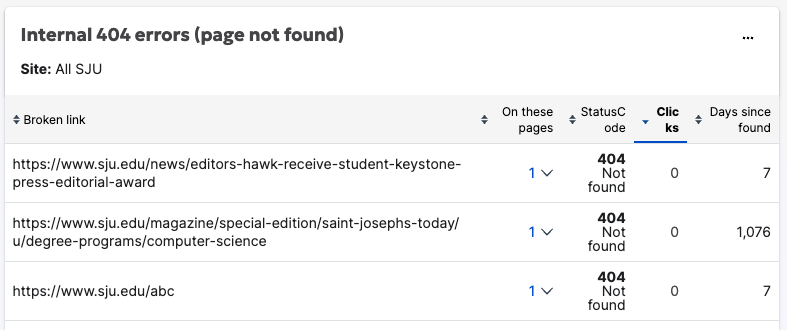
Click on the down arrow, you'll see on which page(s) the broken links occur.
Link Status - Siteimprove divides broken links into those it is absolutely certain are broken and those falling under the "Needs Review" category. Although there are sometimes false positives, you will find that in most cases, those falling under the “Needs Review” category are, in fact, broken. When checking internal links, be sure to do so in incognito mode on your browser in case you're signed into the site.
If the link to an external site or internal page does resolve properly, you can dismiss the broken links as a false positive. Click the "Dismiss" dropdown, select "Dismiss link (for now)" option, and in the comment box write "false positive," then click the "confirm" button.
Once you have fixed a broken link, you can check it by hitting the refresh button to the far left next to the name of the broken link. If it's been fixed, it will be removed from your ist.
Broken links happen, often for reasons outside of our control. But the good news is that these are among the easiest items to address.
Analytics
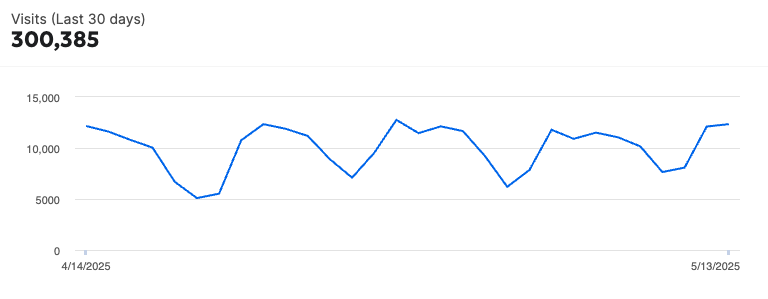
This panel gives you a breakdown of site visits across all pages as recorded by our Google Analytics account over the last 30 days.
Misspellings
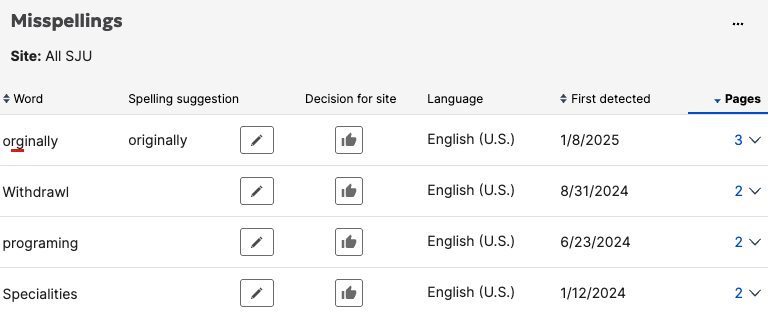
- Spelling suggestions - Provides a very limited number of replacement suggestions when it has them
- Decision for site - Allows you to dismiss words flagged as misspelled from future reports
- First detected - Date of when Siteimprove first identified it on the site
- Pages - The specific pages containing errors (click the down arrows to see a list of them.)
Images
Images missing Alt attributes
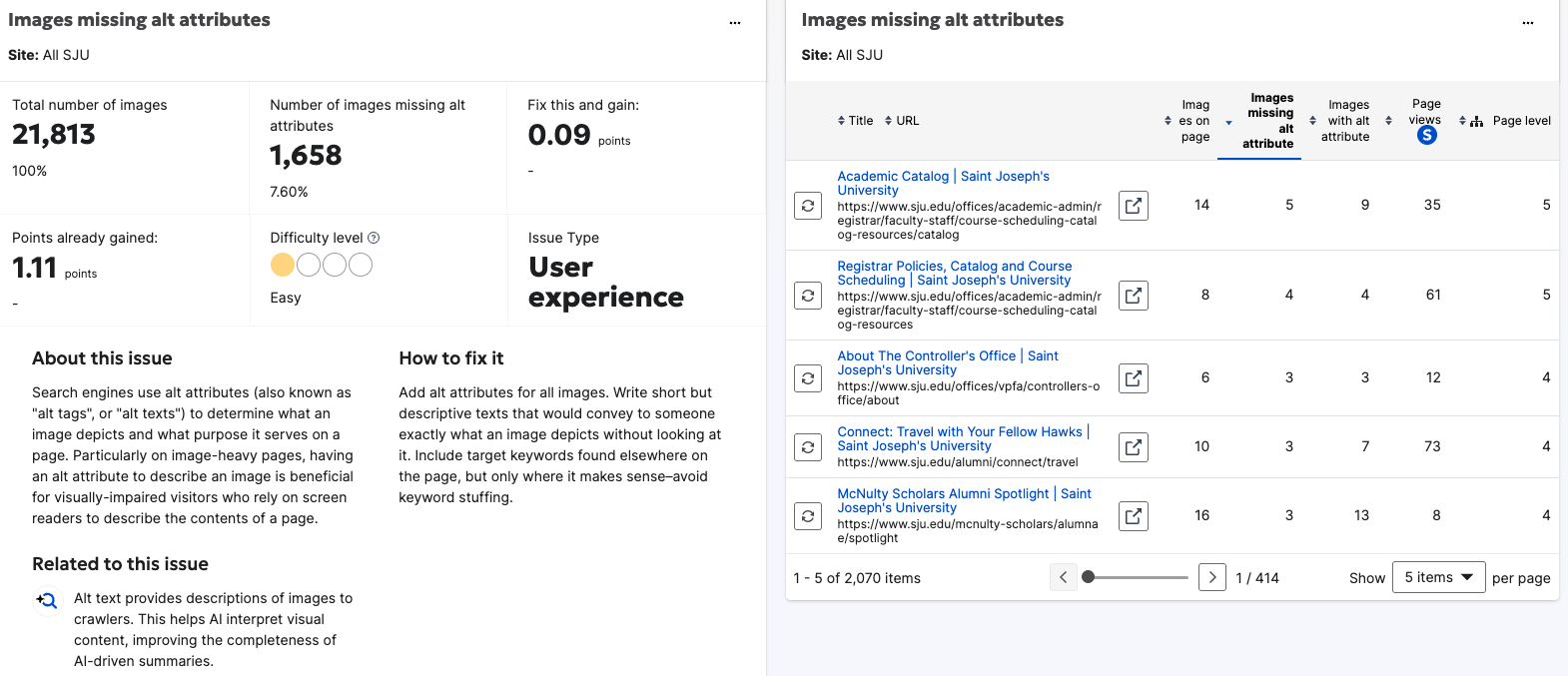
- Images on page - Total number of images on the page
- Images missing alt attribute - Number needing alt tag content added
- Page views - Total page views for pages containing these images
- Page level - Levels removed from the sju.edu homepage
Images larger than 1MB
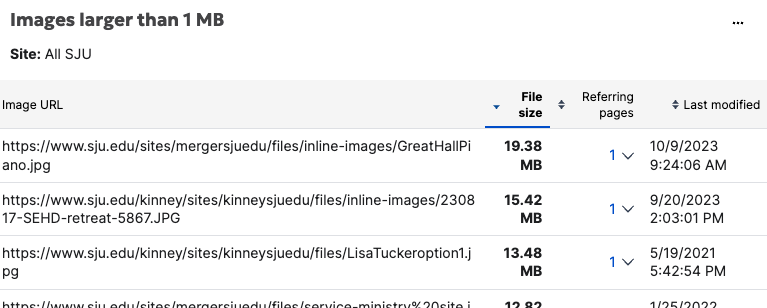
You should not have any images exceeding 1MB on your pages. This can affect search rankings as well as make users wait for images to load, especially on mobile devices.
- Referring Pages - Pages on which these images appear
Meta Tag Sections
Meta titles are too long panels
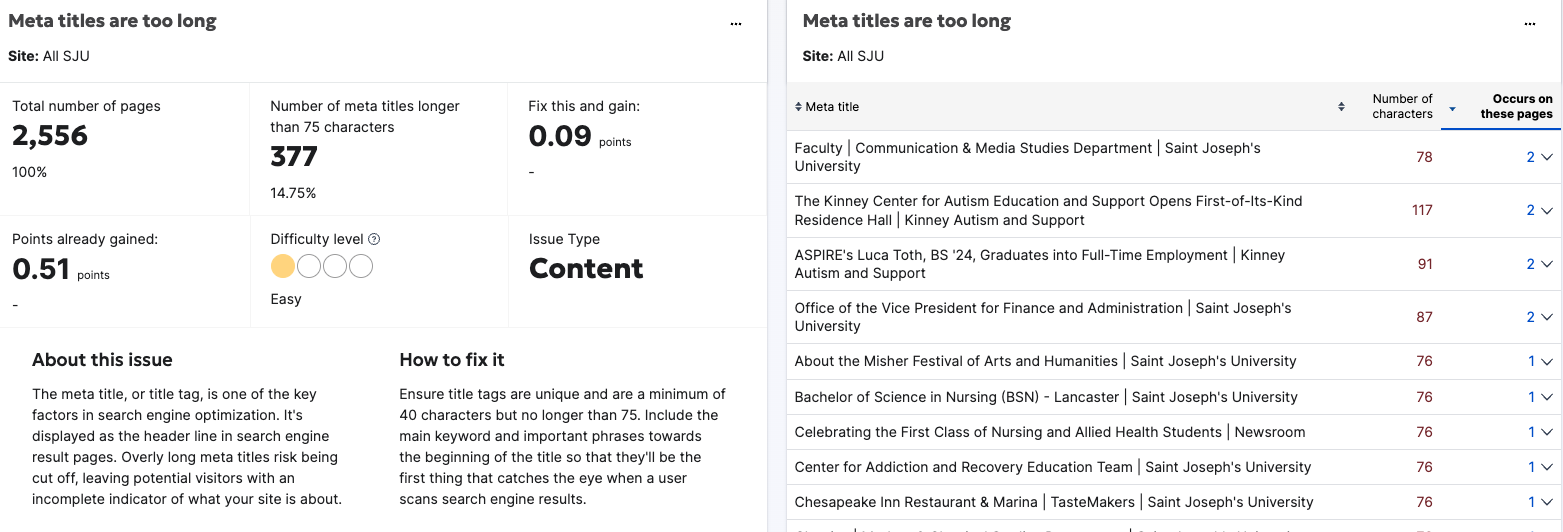
These two panels identify instances of where meta titles exceed 60 characters. Why does this matter? Google typically displays the first 600 pixels of a title tag, which roughly translates to 50–60 characters. Anything longer will get cut off on most devices. However, it’s understood that page titles often exceed this.
This panel gives you the specific meta titles that exceed this length along with the character count.
Meta descriptions are too long panels

Ideally, meta descriptions should be no longer than 160 characters, with 150-160 being the sweet spot. This range gives you enough space to write a compelling summary without being truncated in Google search results, especially on desktop. On mobile, Google may show slightly shorter descriptions (around 120 characters), so it's best to front-load the most important info.
Missing Meta Descriptions Panels
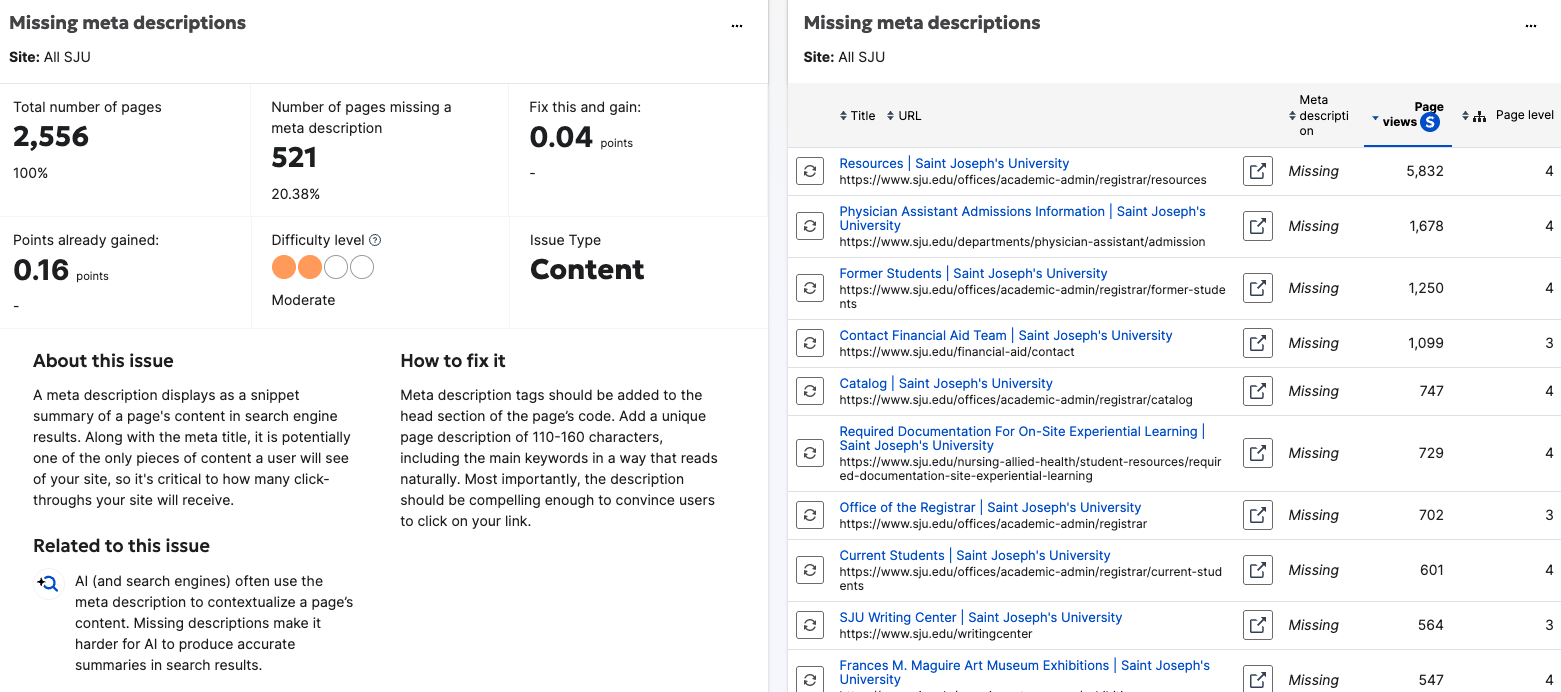
Meta descriptions are key to SEO and, per our web standards, should be on every page of your site. If you don’t provide a meta description, Google will auto-generate one, usually by pulling snippets of text from the page. These auto-generated descriptions may be incoherent, cut off mid-sentence, or fail to highlight your key message or call to action. If you need help in generating and/or filling in meta descriptions, the web team can help.
Content Frequency and Unsafe Links
Frequency of new content
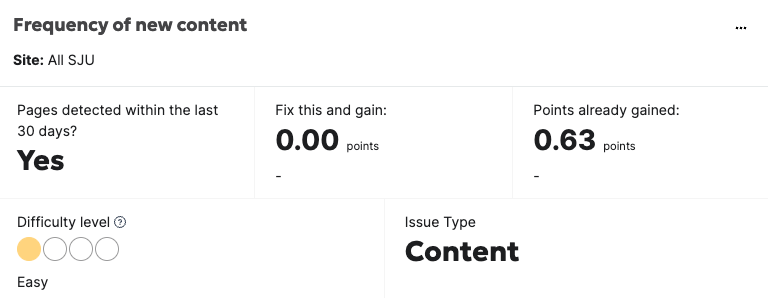
It’s understood that for many sites, fresh content is not necessarily needed for the sites to fulfill their mission and goals. Most time, content will only be refreshed when there is a change in information needed. However, the frequency of new content helps with SEO rankings. Fresh content tends to show search engines there's updated activity on the site in need of indexing and may push up SEO results in relation to comparable pages.
Links to unsafe domains

This will indicate that some pages on your site contain outbound links pointing to websites that are considered harmful or risky by security tools or search engines.
This could mean the linked domains are:
- Lacking HTTPS, which is a basic security standard
- Compromised (e.g., previously safe but now hacked)
- Flagged for malware, phishing, or scams
- Low-quality or spammy (used for link schemes, fake content, etc.)
Given the sites we are linking to, generally respected government sites or publications, we will rarely see a site show up on this report. But if you do see it, you are encouraged to investigate whether the link to the site is absolutely necessary for your purposes.
Crawl Details & Check History
Crawl Details

Siteimprove’s numbers are not real-time. Rather, the program crawls the site from time to time and takes a snapshot of its status across various metrics. So making an update to a site page will not immediately be reflected in the siteimprove report. It will not show up until the site is next crawled. This panel shows you when the site was last crawled and the date for the next crawl.
Check history

- Page count - the number of pages on your minisite
- Link count - the total number of links on your pages
- Broken links - unique broken links on your pages
- Broken links in PDFs - unique broken links in PDFs
- Misspellings - unique misspelled words
Fixing Common Issues
These Siteimprove reports give great information on potential problems, but the problems will not go away on their own. It's important to correct whatever mistakes you see. What can you do to improve your scores and the on-site experience of your visitors?
- Correct instances of broken links.
- Correct misspellings.
- Do not use images >1MB. If replacements are needed, the web team can help you use the same image, but at a greatly reduced size.
- Ensure meta tags are in place and fit best practices. We can help you there as well.
- Pay extra attention to high-traffic pages and those close to your home page.
As always, we are here to help you and your sites succeed. Please submit a web ticket if you have questions or could use help in remediating any issues that pop up on your reports. And thanks for helping make our web presence strong.